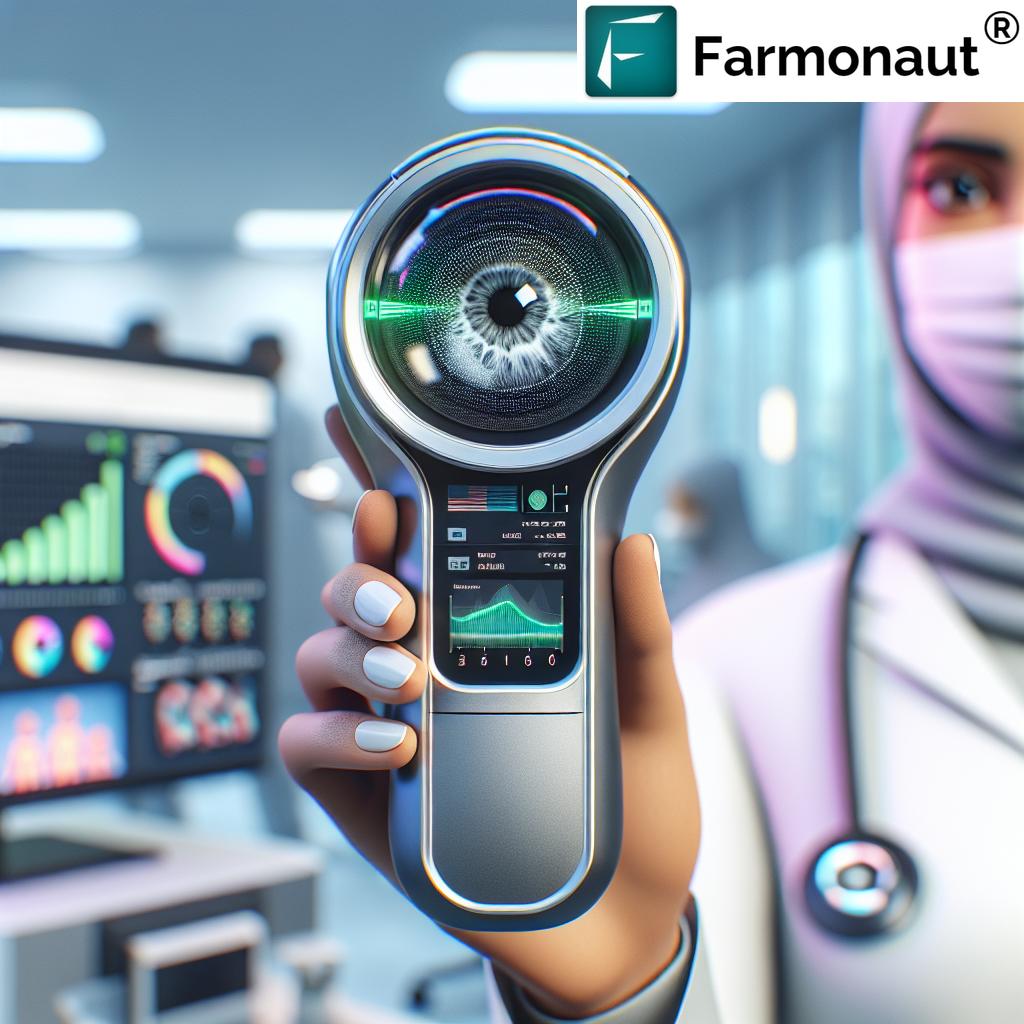Breakthrough in Washington: Innovative Autism Screening Technology Revolutionizes Early Detection for Children
“New handheld device captures high-frequency pupil images, offering an objective autism marker for more efficient diagnosis in children.”
“Innovative autism screening technology measures atypical pupil responses to light stimuli, indirectly assessing brainstem efficiency for early detection.”
In the realm of autism spectrum disorder (ASD) research and diagnosis, we are witnessing a groundbreaking development that promises to revolutionize early detection in children. At the forefront of this innovation is Schweitzer Engineering Laboratories (SEL) in Spokane, Washington, which has ventured into the medical device sector with a clear mission: to enhance the early diagnosis and care for children with autism.
The Dawn of a New Era in Autism Screening
SEL’s recent announcement has sent ripples through the medical community. They are on the cusp of introducing a handheld device that measures atypical light responses in children’s pupils – a potential indicator of autism. This endeavor follows SEL’s strategic acquisition of the technology and the hiring of its visionary developer, Georgina Lynch, in 2024.

To truly appreciate the significance of this development, we must understand the current landscape of autism diagnosis. Autism affects approximately 1 in 36 children, manifesting in varying degrees of social communication issues, along with restrictive and repetitive behaviors. Traditional diagnosis methods are often subjective, primarily relying on behavioral assessments that typically result in diagnosis around the age of four.
The Need for Objective Markers in Autism Screening
Lynch, the mastermind behind this innovative autism screening device, emphasizes the critical need for objective, physical markers in the screening process. The goal is to enhance both the accuracy and efficacy of autism diagnosis. While it’s important to note that the device itself does not offer a definitive diagnosis, it provides invaluable objective data that can significantly aid clinicians during the screening process.
- Objective data collection
- Enhanced accuracy in screening
- Support for clinical decision-making
This advancement in autism spectrum disorder research represents a significant step towards improving the lives of children with autism and their families. By integrating this technology into routine health check-ups, healthcare providers can potentially identify autism indicators earlier, leading to timely access to support services and improved developmental outcomes.
How the Innovative Autism Screening Device Works
The device, designed to be roughly the size of a six-inch-wide tablet, functions by capturing high-frequency images of a child’s pupils responding to light stimuli. These images are taken at an impressive rate of 80 frames per second, providing a detailed analysis of pupil reactions.
This innovative approach allows clinicians to indirectly assess cranial nerve efficiency in the brainstem, potentially revealing neurological differences associated with autism. Lynch draws an insightful parallel, suggesting that measuring light reflexes should become as routine as checking blood pressure during standard health checks.

The Impact on Clinical Settings and Stigma Reduction
Lynch notes that utilizing this device in clinical settings could have far-reaching effects beyond just diagnosis. It has the potential to reduce stigma surrounding autism by facilitating early, objective conversations between doctors and parents regarding potential concerns.
Dawn Sidell, director of the Northwest Autism Center, underscores the importance of early intervention. She stresses that utilizing objective screening tools like this device can lead to earlier access to support services, which she believes can significantly enhance children’s developmental outcomes.
The Significance of Biometric Data in Autism Screening
The significance of gathering biometric data cannot be overstated. Lynch envisions a future where children can be screened for autism spectrum disorder as part of their standard check-ups. This shift could create a more proactive approach toward addressing ASD, helping children and their families access necessary resources sooner.
Sidell echoes this sentiment, noting that early interventions can lead to significant differences in children’s capacity to communicate and engage with their environments. The potential for this technology to transform lives is immense.
Earn With Farmonaut: Join our affiliate program and earn 20% recurring commission by sharing your promo code and helping farmers save 10%. Onboard 10 Elite farmers monthly to earn a minimum of $148,000 annually—start now and grow your income!
Bridging Academia and Industry for Public Health Benefits
SEL’s efforts represent a collaborative stride toward bridging academia and industry in pursuit of public health benefits. As they navigate the necessary federal regulatory requirements for the device, both Lynch and SEL view this as a monumental step forward in the autism space.
Lynch expresses excitement at the potential to apply her research directly in clinical practice, viewing this initiative as an opportunity to make a meaningful impact in the lives of children with autism and their families.
| Screening Method | Objectivity | Speed | Age Range | Key Benefits |
|---|---|---|---|---|
| SEL’s Handheld Pupil Response Device | High | 1-2 minutes | 6 months+ | Objective data, early detection, non-invasive |
| Traditional Behavioral Assessments | Low | 30-60 minutes | 18 months+ | Comprehensive, observes multiple behaviors |
| Genetic Testing | High | Days to weeks | Any | Identifies genetic markers, can detect other conditions |
The Future of Autism Screening and Early Intervention
The development of this handheld device by Schweitzer Engineering Laboratories stands to revolutionize the early detection of autism spectrum disorder, offering an objective screening tool that aligns clinical practices with contemporary neuroscience research. The integration of such technology into routine health assessments presents the possibility of transformative changes in how autism is identified and treated, ultimately seeking to provide better life outcomes for affected children.
As we look to the future, the potential applications of this technology are vast. Researchers are already exploring how this innovative approach to autism screening could be adapted for other neurodevelopmental disorders, potentially broadening its impact on child health and development.
The Role of AI and Machine Learning in Autism Diagnosis
While the pupil response device is groundbreaking in its own right, it’s important to consider how it fits into the broader landscape of technological advancements in autism research. Artificial Intelligence (AI) and machine learning are playing increasingly significant roles in analyzing the complex data associated with autism spectrum disorder.
- AI-assisted analysis of behavioral patterns
- Machine learning algorithms for interpreting biometric data
- Predictive modeling for autism risk assessment
These technologies, when combined with innovative screening devices like SEL’s, have the potential to create a more comprehensive and accurate diagnostic process. The synergy between hardware innovations and software advancements is paving the way for a new era in autism research and care.
Explore Farmonaut’s cutting-edge agricultural solutions:
Challenges and Ethical Considerations
As with any new medical technology, the introduction of this innovative autism screening device brings with it a set of challenges and ethical considerations that must be carefully addressed:
- Ensuring privacy and data protection for young patients
- Addressing potential biases in the screening process
- Balancing early detection with the risk of overdiagnosis
- Ensuring equitable access to new screening technologies
These challenges underscore the need for ongoing dialogue between medical professionals, ethicists, policymakers, and the autism community to ensure that new technologies are implemented responsibly and in the best interests of children and families.
The Global Impact of Early Autism Detection
While this breakthrough is currently centered in Washington state, its potential impact is global. Early detection of autism spectrum disorder is a challenge faced by healthcare systems worldwide. The introduction of objective, efficient screening tools could have far-reaching effects on global public health, potentially reducing the economic and social costs associated with late autism diagnosis.
Furthermore, as this technology becomes more widely available, it could help bridge the gap in autism care between developed and developing nations, where access to specialized behavioral assessments may be limited.
The Role of Parents and Caregivers
While innovative technologies like SEL’s pupil response device are transforming the landscape of autism screening, the role of parents and caregivers remains crucial. Early recognition of potential autism indicators by those closest to the child is often the first step in the diagnostic process.
Parents and caregivers should be encouraged to:
- Monitor their child’s developmental milestones
- Communicate any concerns with healthcare providers
- Seek early intervention services if recommended
- Stay informed about advancements in autism screening and care
By combining parental vigilance with cutting-edge screening technologies, we can create a more robust system for early autism detection and intervention.
The Path Forward: Research and Development
The introduction of SEL’s innovative autism screening device marks a significant milestone, but it’s just the beginning. Ongoing research and development in this field are crucial for continual improvement and expansion of our understanding of autism spectrum disorder.
Future directions for research may include:
- Longitudinal studies on the effectiveness of early detection and intervention
- Integration of multiple biomarkers for more comprehensive screening
- Development of personalized intervention strategies based on screening results
- Exploration of potential applications for other neurodevelopmental disorders
As we move forward, collaboration between researchers, clinicians, and technology developers will be key to realizing the full potential of these innovations in autism care.
Interested in leveraging satellite data for agriculture? Check out Farmonaut’s API and API Developer Docs.
Conclusion: A New Chapter in Autism Care
The development of SEL’s handheld pupil response device for autism screening represents a significant leap forward in our approach to autism spectrum disorder diagnosis and care. By providing an objective, efficient, and early method of detection, this technology has the potential to transform lives, offering children with autism and their families the opportunity for earlier intervention and support.
As we stand on the brink of this new era in autism care, it’s clear that the integration of innovative technologies, continued research, and compassionate care will be key to improving outcomes for individuals with autism spectrum disorder. The future of autism screening is bright, and with each advancement, we move closer to a world where every child with autism can receive the early support they need to thrive.
FAQ Section
Q: What is the new autism screening technology developed in Washington?
A: It’s a handheld device that measures atypical light responses in children’s pupils, potentially indicating autism by capturing high-frequency images at 80 frames per second.
Q: How does this device differ from traditional autism screening methods?
A: Unlike subjective behavioral assessments, this device provides objective data by measuring pupil responses, offering a potential physical marker for autism.
Q: At what age can children be screened using this new technology?
A: While specific age ranges are still being determined, the device aims to enable earlier screening than traditional methods, potentially as early as 6 months of age.
Q: Does this device provide a definitive autism diagnosis?
A: No, it doesn’t provide a definitive diagnosis. Instead, it offers objective data to aid clinicians in the screening process, complementing other diagnostic tools.
Q: How might this technology impact early intervention for autism?
A: By potentially identifying autism indicators earlier, it could lead to more timely access to support services and improved developmental outcomes for children with autism.







**
“Given the potential of this new autism screening device, should we consider implementing mandatory autism screenings for all infants, similar to hearing tests, to ensure early diagnosis and intervention? What ethical and practical implications might arise from such a policy?